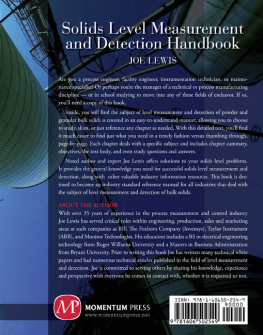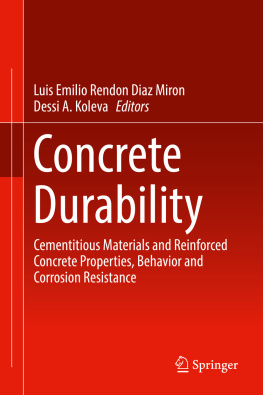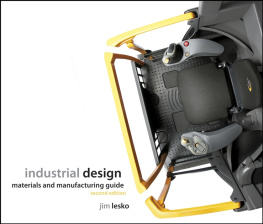SOLIDS LEVEL
MEASUREMENT
AND DETECTION
HANDBOOK
SOLIDS LEVEL
MEASUREMENT
AND DETECTION
HANDBOOK
JOE LEWIS

MOMENTUM PRESS, LLC, NEW YORK
Solids Level Measurement and Detection Handbook
Copyright Momentum Press, LLC, 2012.
All rights reserved. No part of this publication may be reproduced, stored in a retrieval system, or transmitted in any form or by any meanselectronic, mechanical, photocopy, recording, or any otherexcept for brief quotations, not to exceed 400 words, without the prior permission of the publisher.
First published by Momentum Press, LLC
222 East 46th Street, New York, NY 10017
www.momentumpress.net
ISBN-13: 978-1-60650-254-9 (hard back, case bound)
ISBN-10: 1-60650-254-9 (hard back, case bound)
ISBN-13: 978-1-60650-256-3 (e-book)
ISBN-10: 1-60650-256-5 (e-book)
DOI: 10.5643/9781606502563
Cover design by Jonathan Pennell
Interior design by Exeter Premedia Services Private Ltd.,
Chennai, India
10 9 8 7 6 5 4 3 2 1
Printed in the United States of America
Preface
By the end of 2008 I had reached the conclusion that the topic of solids level measurement and monitoring had been inadequately covered in academia and within instrumentation textbooks in general. A dedicated self-tutorial on the topic would be a huge service to a wide variety of people within a range of industries. The stage was set for this book to become reality, but I had yet to realize it.
I had already authored several papers and technical articles within the area of solids level measurement. The new business venture I had begun early in 2009 would continue my involvement in the area of solids level measurement and monitoring and I continued to explore new ways to provide users of solids level instrumentation the information and knowledge they would need to best choose and implement the myriad of products in this area, including the production of podcasts and blogs.
In the spring of 2009 the seed that would become this book was planted during one of many periodic lunches with my friend, automation expert, and magazine editor-in-chief Walt Boyes. By late 2009 a loose proposal for this book was being discussed and in the beginning of 2010 the idea had become a publishing contract with Momentum Press.
Now as I sit writing this Preface, I wonder at the outcome, the result. Will it be the self-tutorial I desire it to become? Will readers embark down the path of self-learning using this book as study guide, course work, and reference material? It is my goal for this to be the case, for each reader to walk away better off for having opened it, read sections, or the contents in its entirety.
I have designed each chapter to stand on its own or be read through in any order the reader chooses along with some or all of the other chapters. There is structure within each chapter, one at a time, together in a grouping, or in their entirety. So with this in mind I invite the reader to embark on a journey, one where you can proceed at your own speed and your own design. Study one chapter at a time or in a group. Test yourself. Come back to a chapter whenever you need to refresh your knowledge. It is my hope and desire for everyone to enjoy the learning from this text as much as I have enjoyed the research and preparation.
And who is the target reader? I have written this book to serve others, with the primary focus on those who find themselves in a variety of jobs including the process engineer, facility engineer, instrumentation technicians, maintenance specialists, managers of technical and process manufacturing disciplines, as well as those in school studying to move into any of these fields of endeavors where the processing, storage, or handling of powders and bulk solids will take place.
Contents
1.1 What Is Level Measurement?
1.2 The Categories of Level Measurement
1.3 Differences Between Liquid and Bulk Solid Levels
1.4 Conclusion
2.1 What Is Point Level Measurement?
2.2 A Word About Process Control
2.3 Point Level Sensor Technology
2.4 Conclusion
3.1 Installation/Process
3.2 Material Characteristics
3.3 Conclusion
4.1 Beam-Breaker
4.2 Radiometric Point Level Sensor
4.3 Conclusion
5.1 Introduction
5.2 Choosing a Measuring Strategy
5.3 Application Considerations
5.4 Conclusion
6.1 Introduction
6.2 Level Measurement Technologies for Contents Inventory Measurement
6.3 Surface Mapping Level Sensor Techniques
6.4 Conclusion
7.1 Introduction
7.2 Stationary Weight Measuring Sensor Systems
7.3 Pressed-In/Bolted-On Strain Gauge Type Sensor System
7.4 Conclusion
8.1 Level Control
8.2 Bin Contents Measurement
8.3 Conclusion
1 Introduction
2 An Introduction to Safety Instrumented Systems and Safety Integrity Levels
3 An Introduction to Hazardous Electrical Locations
4 Conclusion
5 Appendix for Hazardous Locations
1 Introduction
2 Stresses in bulk solids
3 Adhesive forces
4 Flowability
5 Practical determination of flow properties
6 Further measurement methods and devices for the determination of bulk solid properties
7 Summary
Dedication
To: Diana, my loving wife,
Don Morrison and Bob Becker, mentors early in my career,
Eric L. Lewis and Leonora R. Lewis, my parents,
Don Ginesi, flow measurement expert and best friend (after my wife).
Introduction
It was 1964 and I was a young boy of 9 years. We were stationed at Ft. Dix in New Jersey. My dad was a career Army officer, which makes me an Army brat (emphasis on brat). I enjoyed the military family life and think it influenced me heavily, especially in my ability to pull up roots and move around frequently, at anytime and without notice.
During the summer my friends and I ran around the base and played army, dug tunnels and generally got pretty dirty. We had lots of fun to say the least. One memory I have is hanging out in a wooded area overlooking a sand pit. Later I learned it was used as some sort of firing and exercise range, which explains finding empty cartridge shells and some ammunition containers (we collected these). We also found grenade pins and even fragments and components of grenades. We were lucky we never got caught or hurt.
The sand pit must have been in productive use at some point in time because there were two old rusty bins and other mechanical equipment in one area of the pit. Looking back it was probably the hulk of an old concrete batch plant or sand sorting machinery. We would climb on the bins and pretend it was some part of our great assault on a town during World War II. Its funny thinking back on it. Our guns, usually sticks, were Thompson submachine guns like the one Sgt. Saunders used in the TV series Combat, which ran from 1962 to 1967.
I remember one time when we were playing army at the sand pit, a friend of mine began throwing rocks at one of the old steel bins. Hed throw one up high, then another a little lower and then down toward the bottom. I had no idea what he was doing and thought it looked fun, so I started throwing rocks like that too. After a few throws I asked him what in the world we were doing this for. His reply stands out in my mind. Im trying to find out if there is anything in the bin and how full the bin is, he said. This was my first dealing with level detection and measurement of a bulk solid material. I guess God had a plan for me and kept me involved in the area of process bin level measurement throughout much of my adult life. Little did I know that I would end up writing a book on this subject.
Next page




